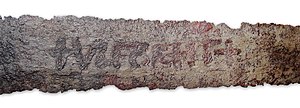
Back Ulfberht Czech Ulfberhtsværd Danish Ulfberht German Espada Ulfberht Spanish Ulfberht-miekka Finnish Ulfberht French Pedang Ulfberht ID Spade Ulfberht Italian ウルフバート Japanese 울프베르트 도검 Korean
| Ulfberht swords | |
|---|---|
 +VLFBEHT+ inscription on the blade of a 9th-century sword (Germanisches Nationalmuseum FG 2187) found in 1960 in the Old Rhine close to Friesenheimer Insel, Mannheim[1] | |
| Type | Sword |
| Production history | |
| Produced | 9th to 11th centuries |
| Specifications | |
| Mass | avg. 1.2 kg (2.7 lb) |
| Length | avg. 91 cm (36 in) |
| Width | 5 cm (2 in) |
| Blade type | Double-edged, straight bladed, slight taper |
| Hilt type | One-handed with pommel, variable guard |
| Head type | Acute distal taper, and point |


The Ulfberht swords are a group of about 170 medieval swords found primarily in Northern Europe,[3][4] dated to the 9th to 11th centuries, with blades inlaid with the inscription +VLFBERH+T or +VLFBERHT+.[3][5] The word "Ulfberht" is a Frankish personal name, possibly indicating the origin of the blades.
- ^ Treasures of German Art and History in the Germanisches Nationalmuseum, Germanisches Nationalmuseum, 2001, p. 23.
- ^ Viacheslav Shpakovsky, David Nicolle, Gerry Embleton, Armies of the Volga Bulgars & Khanate of Kazan, 9th–16th centuries, Osprey Men-at-Arms 491 (2013), p. 23f.
- ^ a b Moilanen, Mikko (2018). Viikinkimiekat Suomessa. Suomalaisen kirjallisuuden seura. pp. 169–175. ISBN 978-952-222-964-9.
- ^ Cite error: The named reference
Williams, 2007was invoked but never defined (see the help page). - ^ Wegeli (1904), p. 12, fig. 3.; Stralsberg (2008:6) classifies the "correctly" spelled inscriptions into five classes, 1. +VLFBERH+T (46 to 51 examples), 2. +VLFBERHT+ (18 to 23 examples), 3. VLFBERH+T (4 to 6 examples), 4. +VLFBERH┼T+ (1 or 2 examples), 5. +VLFBERH+T (10 examples), with a sixth class of "misspellings" (+VLEBERHIT, +VLFBEHT+, +VLFBERH+, +VLFBER├┼┼T, +VLFBERTH, 17 examples) and a seventh class "not definable" (31 or 32 examples). Stalsberg (2008) explains the numerous misspellings in the inscriptions by the "use of illiterate slaves in the smithy".